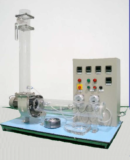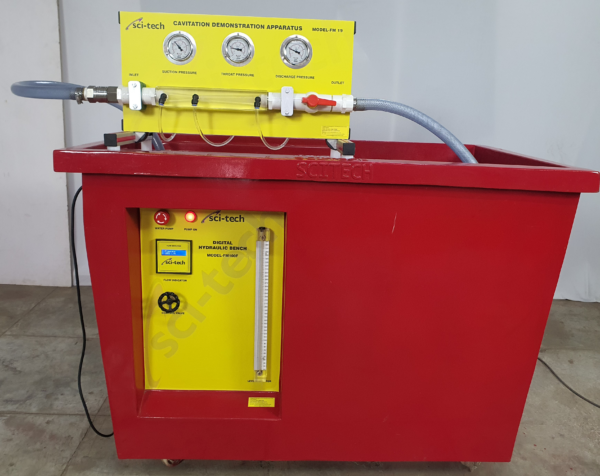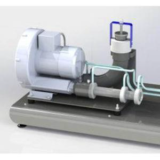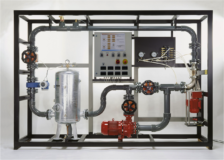Cavitation Demo Apparatus MODEL FM 19
Home » Products » Cavitation Demo Apparatus MODEL FM 19
Cavitation Demo Apparatus MODEL FM 19
The Sci-tech Cavitation Demonstration Apparatus Model FM 19 is a compact bench top unit and has been designed to visualize and study the cavitation phenomenon in water flow. The apparatus consists of a venturi – shaped test section made of clear acrylic to enable visualization of formation of bubbles and subsequent collapse of bubbles in the flow. The upstream section of the venturi is connected to the hydraulic bench or any suitable source of water. The FM 100 Hydraulic Bench or any other standard hydraulic bench models can be used. Cavitation is obtained by reducing pressure at the throat according to Bernoulli equation by varying the flow rate. Flow control valves at the upstream and downstream ends of the test section allow control of flow. Static pressures at the upstream section and the throat are measured using pressure gauges. The flow rate is measured using turbine flow meter. The apparatus can be mounted on the hydraulic bench and is provided with quick release fittings for easy connections. The complete unit is manufactured from corrosion resistant materials.
| Size: | 40cm x 30cm x 30cm (LxWxH) |
| Weight: | 15 kg |
Item Description
Cavitation is a phenomenon in which vapor pockets are released in the liquid flow because of the reduction in the local static pressure. Cavitation occurs in any device handling liquids whenever the local static pressure reduces below the vapor pressure of the liquid. The vapor bubbles formed during cavitation may cause the flow to become unsteady and reduce the performance of devices such as pumps and turbines. Collapsing of vapor bubbles on surfaces cause erosion damage or surface pitting damaging components. Understanding of cavitation phenomenon is important to the students of marine, civil, hydraulic, mechanical, chemical and several other branches of engineering.
The Sci-tech Cavitation Demonstration Apparatus Model FM 19 is a compact bench top unit and has been designed to visualize and study the cavitation phenomenon in water flow. The apparatus consists of a venturi – shaped test section made of clear acrylic to enable visualization of formation of bubbles and subsequent collapse of bubbles in the flow. The upstream section of the venturi is connected to the hydraulic bench or any suitable source of water. The FM 100 Hydraulic Bench or any other standard hydraulic bench models can be used. Cavitation is obtained by reducing pressure at the throat according to Bernoulli equation by varying the flow rate. Flow control valves at the upstream and downstream ends of the test section allow control of flow. Static pressures at the upstream section and the throat are measured using pressure gauges. The flow rate is measured using turbine flow meter. The apparatus can be mounted on the hydraulic bench and is provided with quick release fittings for easy connections. The complete unit is manufactured from corrosion resistant materials.
OPTION
Computer based learning ‘Sci-cal’ software is included to enable students understand and conduct experiments, tabulate results and plot graphs. The Sci-tech Cavitation Demonstration Apparatus is an important experimental set-up for any Fluid Mechanics and Hydraulics Laboratory of an educational institution.
See also different:

Sci-tech Multi-stage Centrifugal Compressor Demonstration Apparatus Model FM 099 allows the students to measure the operation characteristics of a multistage centrifugal compressor. For that purpose, the unit carries out the actual measurement [...]



